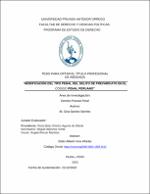Mostrar el registro sencillo del ítem
Modificación del tipo penal del delito de prevaricato en el código penal peruano
| dc.contributor.advisor | Vera Infantes, Edder Alberto | |
| dc.contributor.author | Sanchez Sanchez, Gina | |
| dc.creator | Sanchez Sanchez, Gina | |
| dc.date.accessioned | 2024-02-13T14:09:27Z | |
| dc.date.available | 2024-02-13T14:09:27Z | |
| dc.date.issued | 2024 | |
| dc.identifier.uri | https://hdl.handle.net/20.500.12759/21291 | |
| dc.description.abstract | La presente investigación toca uno de los problemas observados y harto discutidos en el sistema de administración de justicia al que hemos denominado: “MODIFICACIÓN DEL TIPO PENAL DEL DELITO DE PREVARICATO EN EL CÓDIGO PENAL PERUANO”. Este tema ha sido objeto de debate por connotados doctrinarios y operadores de justicia en nuestro medio; el presente trabajo se centra en determinar de qué manera se debe tipificar el delito de prevaricato en el Perú, habida cuenta que la actual redacción es muy corta y puede generar vacíos de impunidad. Así pues, en aras de conseguir el objetivo trazado se usaron los métodos lógicos, siguiendo un análisis deductivo, analítico – sintético y comparativo, también hemos recurrido a los métodos jurídicos en los cuales nos permiten interpretar hermenéuticamente el código penal y específicamente el articulo 418y sus alcances; al mismo tiempo, mediante el método doctrinario seleccionamos las posturas que se ajusten a nuestras posturas. Al final, con los argumentos esgrimidos durante la investigación proponga un nuevo texto legal que debe adoptar el artículo 418 del Código Penal peruano referido al delito de prevaricato | es_PE |
| dc.description.abstract | The present investigation touches on one of the problems observed and widely discussed in the justice administration system that we have called: ““MODIFICATION OF THE CRIMINAL TYPE OF THE CRIME OF PREVARICATO IN THE PERUVIAN PENAL CODE““. This issue has been the subject of debate by renowned doctrinaires and justice operators in our midst; the present work focuses on determining how the crime of malfeasance should be defined in Peru, given that the current wording is very short and can generate impunity gaps. Thus, in order to achieve the stated objective, logical methods were used, following a deductive, analytical - synthetic and comparative analysis, we have also resorted to legal methods in which they allow us to hermeneutically interpret the penal code and specifically article 418 and its scopes; at the same time, through the doctrinal method we select the positions that fit our positions. In the end, with the arguments put forward during the investigation, propose a new legal text that should adopt article 418 of the Peruvian Penal Code referring to the crime of malfeasance | es_PE |
| dc.description.uri | Tesis | es_PE |
| dc.format | application/pdf | es_PE |
| dc.language.iso | spa | es_PE |
| dc.publisher | Universidad Privada Antenor Orrego | es_PE |
| dc.relation.ispartofseries | T_DEREP_043 | |
| dc.rights | info:eu-repo/semantics/openAccess | es_PE |
| dc.rights.uri | https://creativecommons.org/licenses/by/4.0/ | es_PE |
| dc.source | Universidad Privada Antenor Orrego | es_PE |
| dc.source | Repositorio Institucional - UPAO | es_PE |
| dc.subject | Codigo Penal | es_PE |
| dc.subject | Prevaricato | es_PE |
| dc.title | Modificación del tipo penal del delito de prevaricato en el código penal peruano | es_PE |
| dc.type | info:eu-repo/semantics/bachelorThesis | es_PE |
| thesis.degree.level | Título Profesional | es_PE |
| thesis.degree.grantor | Universidad Privada Antenor Orrego. Facultad de Derecho y Ciencias Politicas | es_PE |
| thesis.degree.name | Abogada | es_PE |
| thesis.degree.discipline | Derecho | es_PE |
| dc.subject.ocde | https://purl.org/pe-repo/ocde/ford#5.05.00 | es_PE |
| renati.advisor.orcid | https://orcid.org/0000-0002-1565-2613 | es_PE |
| renati.author.dni | 45945602 | |
| renati.advisor.dni | 42405171 | |
| renati.type | https://purl.org/pe-repo/renati/type#tesis | es_PE |
| renati.level | https://purl.org/pe-repo/renati/level#tituloProfesional | es_PE |
| renati.discipline | 421016 | es_PE |
| renati.juror | Aguirre de Infante Ortecho, Rocio Belu | |
| renati.juror | Albornoz Verde, Miguel | |
| renati.juror | Rincon Martinez, Angela | |
| dc.publisher.country | PE | es_PE |
Ficheros en el ítem
Este ítem aparece en la(s) siguiente(s) colección(es)
-
Derecho [477]




